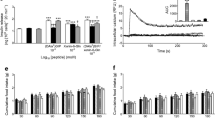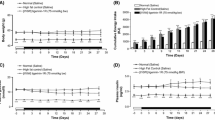Abstract
Aims
Xenin-25 is co-secreted with glucose-dependent insulinotropic polypeptide (GIP) from intestinal K-cells following a meal. Xenin-25 is believed to play a key role in glucose homoeostasis and potentiate the insulinotropic effect of GIP.
Methods
This study investigated the effects of sub-chronic administration of the stable and longer-acting xenin-25 analogue, xenin-25[Lys13PAL] (25 nmol/kg), in diabetic mice fed with a high-fat diet.
Results
Initial studies confirmed the significant persistent glucose-lowering (p < 0.05) and insulin-releasing (p < 0.05) actions of xenin-25[Lys13PAL] compared with native xenin-25. Interestingly, xenin-25 retained significant glucose-lowering activity in GIP receptor knockout mice. Twice-daily intraperitoneal (i.p.) injection of xenin-25[Lys13PAL] for 14 days had no significant effect on food intake or body weight in high-fat-fed mice. Non-fasting glucose and insulin levels were also unchanged, but overall glucose levels during an i.p. glucose tolerance and oral nutrient challenge were significantly (p < 0.05) lowered by xenin-25[Lys13PAL] treatment. These changes were accompanied by significant improvements in i.p. (p < 0.05) and oral (p < 0.001) nutrient-stimulated insulin concentrations. No appreciable changes in insulin sensitivity were observed between xenin-25[Lys13PAL] and saline-treated high-fat mice. However, xenin-25[Lys13PAL] treatment restored notable sensitivity to the biological actions of exogenous GIP injection. Consumption of O2, production of CO2, respiratory exchange ratio and energy expenditure were not altered by 14-day twice-daily treatment with xenin-25[Lys13PAL]. In contrast, ambulatory activity was significantly (p < 0.05 to p < 0.001) increased during the dark phase in xenin-25[Lys13PAL] mice compared with high-fat controls.
Conclusions
These data indicate that sustained administration of a stable analogue of xenin-25 exerts a spectrum of beneficial metabolic effects in high-fat-fed mice.









Similar content being viewed by others
References
Feurle GE, Ikonomu S, Partoulas G, Stoschus B, Hamscher G (2003) Xenin plasma concentrations during modified sham feeding and during meals of different composition demonstrated by radioimmunoassay and chromatography. Regul Pept 111:153–159
Cooke JH, Patterson M, Patel SR, Smith KL, Ghatei MA, Bloom SR, Murphy KG (2009) Peripheral and central administration of xenin and neurotensin suppress food intake in rodents. Obesity (Silver Spring) 17:1135–1143
Taylor AI, Irwin N, McKillop AM, Patterson S, Flatt PR, Gault VA (2010) Evaluation of the degradation and metabolic effects of the gut peptide xenin on insulin secretion, glycaemic control and satiety. J Endocrinol 207:87–93
Kamiyama Y, Aihara R, Nakabayashi T, Mochiki E, Asao T, Kuwano H (2007) The peptide hormone xenin induces gallbladder contractions in conscious dogs. Neurogastroenterol Motil 19:33–240
Leckstrom A, Kim ER, Wong D, Mizuno TM (2009) Xenin, a gastrointestinal peptide, regulates feeding independent of the melanocortin signaling pathway. Diabetes 58:87–94
Wice BM, Wang S, Crimmins DL, Diggs-Andrews KA, Althage MC, Ford EL, Tran H, Ohlendorf M, Griest TA, Wang Q, Fisher SJ, Ladenson JH, Polonsky KS (2010) Xenin-25 potentiates glucose-dependent insulinotropic polypeptide action via a novel cholinergic relay mechanism. J Biol Chem 2285:19842–19853
Martin CM, Gault VA, McClean S, Flatt PR, Irwin N (2012) Degradation, insulin secretion, glucose-lowering and GIP additive actions of a palmitate-derivatised analogue of xenin-25. Biochem Pharmacol 84:312–319
Holst JJ, Knop FK, Vilsbøll T, Krarup T, Madsbad S (2011) Loss of incretin effect is a specific, important, and early characteristic of type 2 diabetes. Diabetes Care 34:S251–S257
Pederson RA, Brown JC (1976) The insulinotropic action of gastric inhibitory polypeptide in the perfused isolated rat pancreas. Endocrinology 99:780–785
Gallwitz B (2011) Glucagon-like peptide-1 analogues for Type 2 diabetes mellitus: current and emerging agents. Drugs 71:1675–1688
Martin CM, Parthsarathy V, Pathak V, Gault VA, Flatt PR, Irwin N (2014) Characterisation of the biological activity of xenin-25 degradation fragment peptides. J Endocrinol 221:193–200
Mieczkowska A, Irwin N, Flatt PR, Chappard D, Mabilleau G (2013) Glucose-dependent insulinotropic polypeptide (GIP) receptor deletion leads to reduced bone strength and quality. Bone 56:337–342
Flatt PR, Bailey CJ (1981) Abnormal plasma glucose and insulin responses in heterozygous lean (ob/+) mice. Diabetologia 20:573–577
Irwin N, Flatt PR (2009) Therapeutic potential for GIP receptor agonists and antagonists. Best Pract Res Clin Endocrinol Metab 23:499–512
Porter DW, Kerr BD, Flatt PR, Holscher C, Gault VA (2010) Four weeks administration of Liraglutide improves memory and learning as well as glycaemic control in mice with high fat dietary-induced obesity and insulin resistance. Diabetes Obes Metab 12:891–899
Gault VA, Porter DW, Irwin N, Flatt PR (2011) Comparison of sub-chronic metabolic effects of stable forms of naturally occurring GIP(1-30) and GIP(1-42) in high-fat fed mice. J Endocrinol 208:265–271
Irwin N, Clarke GC, Green BD, Greer B, Harriott P, Gault VA, O’Harte FP, Flatt PR (2006) Evaluation of the antidiabetic activity of DPP IV resistant N-terminally modified versus mid-chain acylated analogues of glucose-dependent insulinotropic polypeptide. Biochem Pharmacol 72:719–728
Wice BM, Reeds DN, Tran HD, Crimmins DL, Patterson BW, Dunai J, Wallendorf MJ, Ladenson JH, Villareal DT, Polonsky KS (2012) Xenin-25 amplifies GIP-mediated insulin secretion in humans with normal and impaired glucose tolerance but not type 2 diabetes. Diabetes 61:1793–1800
Pathak V, Vasu S, Flatt PR, Irwin N (2014) Effects of chronic exposure of clonal β-cells to elevated glucose and free fatty acids on incretin receptor gene expression and secretory responses to GIP and GLP-1. Diabetes Obes Metab 16:357–365
Piteau S, Olver A, Kim SJ, Winter K, Pospisilik JA, Lynn F, Manhart S, Demuth HU, Speck M, Pederson RA, McIntosh CH (2007) Reversal of islet GIP receptor down-regulation and resistance to GIP by reducing hyperglycemia in the Zucker rat. Biochem Biophys Res Commun 362:1007–1012
Salera M, Giacomoni P, Pironi L, Cornia G, Capelli M, Marini A, Benfenati F, Miglioli M, Barbara L (1982) Gastric inhibitory polypeptide release after oral glucose: relationship to glucose intolerance, diabetes mellitus, and obesity. J Clin Endocrinol Metab 55:329–336
Marks V (1988) In: James WPT, Parker SW (eds) Current approaches: obesity. Southampton, Duphar Medical Relations, pp 13–19
Yip RG, Wolfe MM (2000) GIP biology and fat metabolism. Life Sci 66:91–103
Kwasowski P, Flatt PR, Bailey CJ, Marks V (1985) Effects of fatty acid chain length and saturation on gastric inhibitory polypeptide release in obese hyperglycaemic (ob/ob) mice. Biosci Rep 5:701–705
Silvestre RA, Rodríguez-Gallardo J, Egido EM, Hernández R, Marco J (2003) Stimulatory effect of xenin-8 on insulin and glucagon secretion in the perfused rat pancreas. Regul Pept 115:25–29
Chowdhury S, Reeds DN, Crimmins DL, Patterson BW, Laciny E, Wang S, Tran HD, Griest TA, Rometo DA, Dunai J, Wallendorf MJ, Ladenson JH, Polonsky K, Wice BM (2014) Xenin-25 delays gastric emptying and reduces postprandial glucose levels in humans with and without type 2 diabetes. Am J Physiol Gastrointest Liver Physiol 306:G301–G309
Miyawaki K, Yamada Y, Ban N, Ihara Y, Tsukiyama K, Zhou H, Fujimoto S, Oku A, Tsuda K, Toyokuni S, Hiai H, Mizunoya W, Fushiki T, Holst JJ, Makino M, Tashita A, Kobara Y, Tsubamoto Y, Jinnouchi T, Jomori T, Seino Y (2002) Inhibition of gastric inhibitory polypeptide signaling prevents obesity. Nat Med 8:738–742
Acknowledgments
These studies were supported by the Department of Education and Learning, Northern Ireland, University of Ulster Proof of Principle Funding Programme, the European Foundation for the Study of Diabetes and a research grant from Invest Northern Ireland Proof of Concept funding.
Conflict of interest
V.A.G., P.R.F. and N.I. hold stock in Diabetica Ltd. which has patents for exploitation of incretin-based drugs and other peptide therapeutics. C.M.A.M. and V.P. declare that they have no conflict of interest.
Ethical standard
All animal experiments were carried out in accordance with the UK Animals (Scientific Procedures) Act 1986 and approved by the University of Ulster Animal Ethics Review Committee. All necessary steps were taken to ameliorate any potential animal suffering.
Human and animal rights disclosure
This article does not contain any studies with human subjects. All animal experiments were carried out in accordance with the UK Animals (Scientific Procedures) Act 1986.
Author information
Authors and Affiliations
Corresponding author
Additional information
Managed by Massimo Porta.
Rights and permissions
About this article
Cite this article
Gault, V.A., Martin, C.M.A., Flatt, P.R. et al. Xenin-25[Lys13PAL]: a novel long-acting acylated analogue of xenin-25 with promising antidiabetic potential. Acta Diabetol 52, 461–471 (2015). https://doi.org/10.1007/s00592-014-0681-0
Received:
Accepted:
Published:
Issue Date:
DOI: https://doi.org/10.1007/s00592-014-0681-0




